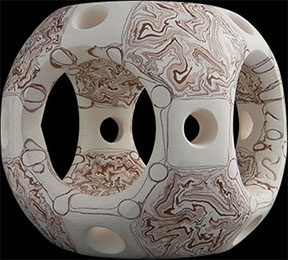PORCELAINia
Spheres of Pythagoras
|
HOME PROCESS SERIES STYLE SCIENCE CARBON ABOUT CONTACT CREDITS 2000 GALLERY |
 Abu'l Wafa Great Rhombicuboctahedron: 118 grams/5.8 cm high On exhibit at St Joseph Gallery-Leeuwarden-The Netherlands |
|
Abu’l Wafa 10th Century CE
Pythagoras’ contributions went well beyond Greece by influencing Arab science, geometry and art in the Middle Ages. The foundations of trigonometry, infused by the Pythagorean theorem, laid the foundations for Islamic mosaics and Arabesque calligraphy. Pythagoras was the first to talk about the Earth as a sphere (four centuries after him it was proven by Eratosthenes through triangulation). In the 10th century, Arabs developed more ancient astronomical instruments such as the astrolabe and quadrant to a level of complexity that allowed them to tell time at night and understand the spherical cosmos. Mohammed Abu’l Wafa al-Buzjani, a mathematician and astronomer in 10th century Baghdad was strongly inspired by Pythagoras’ work. He offered one of the 76 proofs for the Pythagorean theorem (proof by dissecting the square). Abu’l Wafa was likely the first to build a wall quadrant to observe the stars. He “invented” the tangent and compiled the earliest tables of sines and tangents to investigate the orbit of the Moon and to observe the motions of the heavenly bodies.











